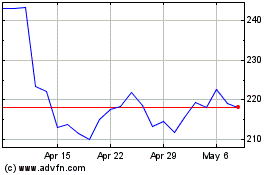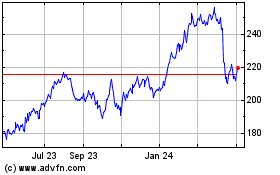Cooking at home overwhelmingly preferred
(80%) to eating out
Primerica, Inc. (NYSE: PRI), a leading provider of financial
services and products in the United States and Canada, released its
Financial Security Monitor™ (FSM™) survey for the second quarter of
2024. This national survey sheds light on the sentiments of
consumers regarding their economic stability during this quarter
finding that even amid reports of an improving economy they are not
feeling the effects in their pocketbooks. Two-thirds of
middle-income families reported they are falling behind the cost of
living.
This press release features multimedia. View
the full release here:
https://www.businesswire.com/news/home/20240626551113/en/
Primerica Household Budget Index™ (HBI™)
- Middle-income households experienced a slight increase in
purchasing power as the HBI™ rose for the first time in 5 months —
100.3% in May, up from 100.1% in April 2024. While a positive
indicator as inflation slows down, middle-income households are
still struggling to make up financial ground, with purchasing power
running only slightly higher than the index baseline of January
2019. (Graphic: Business Wire)
This perception may be influencing individual financial habits
with 80% of households reportedly cooking more meals at home
instead of dining out or ordering takeout over the past year. The
top two reasons for this shift in behavior were budget concerns,
with 72% of respondents acknowledging this as a primary factor,
followed by unreasonably high restaurant prices, which was a key
factor for 62% of respondents.
“Middle-income families are continuing to make adjustments in
their budgets in an attempt to manage the ongoing high cost of
living,” said Glenn Williams, CEO of Primerica. “Unfortunately,
their difficult decisions include the increasing use of credit
cards and scaling back saving for the future, which both could
negatively impact their long-term financial condition.”
This latest FSM™ survey coincides with the release of
Primerica’s Household Budget Index™ (HBI™), which indicates
middle-income households experienced a slight increase in
purchasing power as the HBI™ rose for the first time in 5 months —
100.3% in May, up from 100.1% in April 2024. While a positive
indicator as inflation slows down, middle-income households are
still struggling to make up financial ground, with purchasing power
running only slightly higher than the index baseline of January
2019.
“It’s mildly encouraging that, after taking overall inflation
into account, middle-income households saw an average real income
gain of 1.3% over the past 12 months,” said Amy Crews Cutts, Ph.D.,
CBE®, economic consultant to Primerica. “Yet as gasoline prices
fell, the costs of other necessity goods rose more quickly, and it
will take time for people to feel that both the broader economic
and their own financial standing are on the rise.”
Key Findings from Primerica’s U.S. Middle-Income Financial
Security Monitor
- Reports of cutting costs or pausing savings altogether by
middle-income families remained steady. During the first
quarter, 46% of families reported they were scaling back with 48%
reporting the same during the second quarter.
- The percentage of people cooking at home has increased.
There is a major shift in spending and saving habits among
middle-income families, including a staggering 4:1 ratio of
families who report cooking meals at home compared to eating at
restaurants or ordering takeout.
- Majority grasp financial basics but not complexities.
Overall, two-thirds (65%) of households feel confident in making
sound financial decisions without outside help, particularly when
it comes to financial fundamentals like building good credit (87%
confident), paying down credit card debt (83%) and creating and
following a financial budget (74%). However, households continue to
express less confidence when it comes to more complex financial
matters, including setting up a retirement account such as a 401(k)
or Individual Retirement Account (IRA) (66% confident), buying life
insurance (63%), and investing in stocks (50%).
- Anxiety and limited time are the main drivers in lack
of financial planning. More than a quarter (31%) say they don’t
contribute to a savings account, follow a budget, contribute to an
investment account or set a financial budget each month. Anxiety
(29%) and not having time (19%) continue to be cited as the biggest
challenges people have tracking their financial information.
Primerica Financial Security Monitor™ (FSM™) Topline Trends
Data
Jun
2024
Mar
2024
Dec
2023
Sept
2023
Jun
2023
Mar
2023
Dec
2022
Sep
2022
Jun
2022
How would you rate the condition of
your personal finances? Share reporting “Excellent” or
“good.”
49%
50%
50%
49%
50%
52%
53%
53%
54%
Analysis: Respondents remain split on
their assessment of their personal finances.
Overall, would you say your income
is…?
Share reporting “Falling behind the
cost of living”
66%
67%
68%
72%
71%
72%
72%
75%
75%
Share reporting “Stayed about even with
the cost of living”
26%
25%
24%
20%
22%
21%
20%
19%
20%
Analysis: Concern about meeting the
increased cost of living remained steady with two-thirds reporting
they are falling behind the cost of living.
And in the next year, do you think the
American economy will be…?
Share reporting “Worse off than it is
now”
40%
46%
53%
56%
57%
53%
56%
51%
61%
Share reporting “Uncertain”
19%
18%
9%
9%
9%
7%
8%
8%
8%
Analysis: Fewer respondents think the
economy will get worse over the next year, while more are uncertain
about the direction of the economy.
Do you have an emergency fund that
would cover an expense of $1,000 or more (for example, if your car
broke down or you had a large medical bill)? (Reporting “Yes”
responses.)
63%
62%
60%
62%
61%
58%
59%
60%
61%
Analysis: The percentage of Americans
who have an emergency fund that would cover an expense of $1,000 or
more has slightly improved over the past year.
How would you rate the economic health
of your community? (Reporting “Not so good” and “Poor”
responses.)
58%
60%
57%
55%
54%
59%
53%
55%
58%
Analysis: Respondents’ rating of the
economic health of their communities has gotten slightly worse over
the past year.
How would you rate your ability to save
for the future? (Reporting “Not so good” and “Poor”
responses.)
68%
67%
73%
71%
71%
73%
74%
73%
72%
Analysis: Though slightly improving, a
significant majority continue to feel it is difficult to save for
the future.
In the past three months, has your
credit card debt…? (Reporting “Increased” responses.)
30%
34%
35%
34%
33%
33%
39%
37%
29%
Analysis: Credit card debt has fallen
slightly over the past year.
About Primerica’s Middle-Income Financial Security Monitor™
(FSM™)
Since September 2020, the Primerica Financial Security Monitor™
has surveyed middle-income households quarterly to gain a clear
picture of their financial situation, and it coincides with the
release of the monthly HBI™ four times annually. Polling was
conducted online from June 8-11, 2024. Using Dynamic Online
Sampling, Change Research polled 1,017 adults nationwide with
incomes between $30,000 and $130,000. Post-stratification weights
were made on gender, age, race, education and Census region to
reflect the population of these adults based on the five-year
averages in the 2021 American Community Survey, published by the
U.S. Census. The margin of error is 3.0%. For more information
visit Primerica.com/public/financial-security-monitor.html.
About the Primerica Household Budget Index™ (HBI™)
The Primerica Household Budget Index™ (HBI™) is constructed
monthly on behalf of Primerica by its chief economic consultant Amy
Crews Cutts, PhD, CBE®. The index measures the purchasing power of
middle-income families with household incomes from $30,000 to
$130,000 and is developed using data from the U.S. Bureau of Labor
Statistics, the US Bureau of the Census, and the Federal Reserve
Bank of Kansas City. The index looks at the cost of necessities
including food, gas, utilities, and health care and earned income
to track differences in inflation and wage growth.
The HBI™ is presented as a percentage. If the index is above
100%, the purchasing power of middle-income families is stronger
than in the baseline period and they may have extra money left over
at the end of the month that can be applied to things like
entertainment, extra savings, or debt reduction. If it is under
100%, households may have to reduce overall spending to levels
below budget, reduce their savings or increase debt to cover
expenses. The HBI™ uses January 2019 as its baseline. This point in
time reflects a recent “normal” economic time prior to the COVID-19
pandemic.
Periodically, prior HBI™ values may be revised due to revisions
in the CPI series and Consumer Expenditure Survey releases by the
U.S. Bureau of Labor Statistics (BLS). Beginning with the October
2023 release of the HBI™ data, health insurance costs will no
longer be included in the calculation of the HBI™ data as part of
the healthcare component because of some newly acknowledged
methodology that has been used by the BLS to calculate the health
insurance CPI. The health insurance CPI, as calculated by BLS, does
not measure consumer costs of health insurance such as the cost of
premiums paid or a combination of premiums and deductibles, but
rather premium values retained by health insurers we do not believe
it accurately reflects consumer experiences. The healthcare
component will continue to include medical services, prescription
drugs and equipment. Prior published values have been adjusted to
reflect this change. For more information visit
householdbudgetindex.com.
About Primerica, Inc.
Primerica, Inc., headquartered in Duluth, GA, is a leading
provider of financial products and services to middle-income
households in North America. Independent licensed representatives
educate Primerica clients about how to better prepare for a more
secure financial future by assessing their needs and providing
appropriate solutions through term life insurance, which we
underwrite, and mutual funds, annuities and other financial
products, which we distribute primarily on behalf of third parties.
We insured approximately 5.7 million lives and had approximately
2.9 million client investment accounts on December 31, 2023.
Primerica, through its insurance company subsidiaries, was the #2
issuer of Term Life insurance coverage in the United States and
Canada in 2023. Primerica stock is included in the S&P MidCap
400 and the Russell 1000 stock indices and is traded on The New
York Stock Exchange under the symbol “PRI”.
View source
version on businesswire.com: https://www.businesswire.com/news/home/20240626551113/en/
Public Relations Gana Ahn, 678-431-9266
gana.ahn@primerica.com
Investor Relations Nicole Russell, 470-564-6663
nicole.russell@primerica.com
Primerica (NYSE:PRI)
Historical Stock Chart
From Dec 2024 to Jan 2025

Primerica (NYSE:PRI)
Historical Stock Chart
From Jan 2024 to Jan 2025
